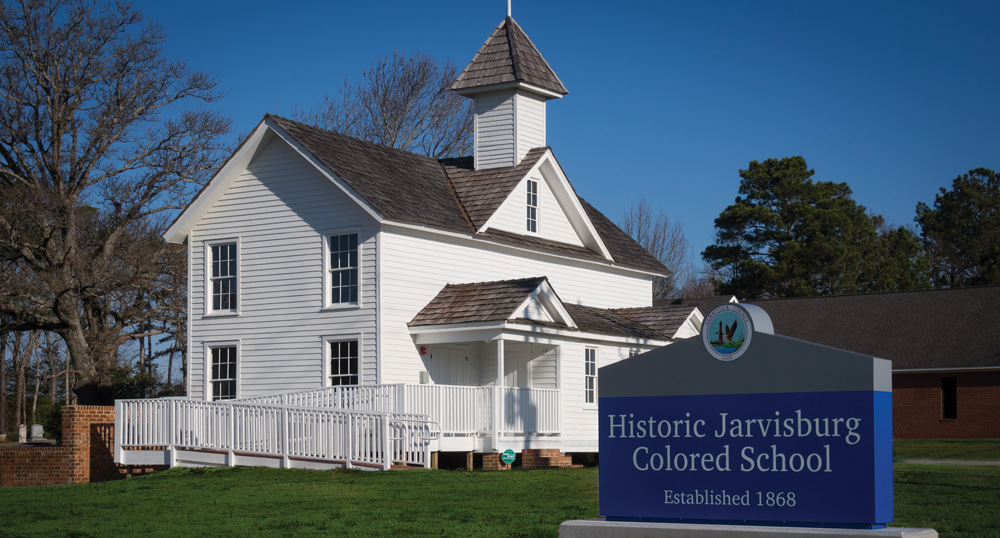
The African American Experience of Northeast North Carolina trail that winds its way through the northeastern part of the state is a trail of triumph and tears.
The self-guided tour of more than 30 sites in nine counties follows the history of the African American experience in the region.
Supporter Spotlight
The counties that are part of the trail – Dare, Currituck, Camden, Pasquotank, Gates, Perquimans, Chowan, Washington and Martin – encompass much of what was Albemarle County when the northeast corner was the property of Lord Proprietor George Monck, 1st Duke of Albemarle in the mid-1600s.
Created as a cooperative agreement among the tourism departments and commissioners of the counties to market the history of the region, the idea for the trail began with the Jarvisburg Colored School, a simple white, wooden building along U.S. Highway 158 in Currituck County.
Founded in 1867 with a land grant from a freed formerly enslaved man, William B. Hunt, the historic school, now a museum, has been meticulously restored, and is generally thought to be the oldest African American school still standing in the state. On the National Register of Historic Places, the building is a rare example of a pre-Rosenwald school.
The school is where the idea for the trail began, when Currituck Travel and Tourism Director Tameron T. Kugler started thinking about how to let people know about the building.
“I was sitting there one day thinking, ‘I’ve got this beautiful little school called the Historic Jarvisburg Colored School. How do I market it?,’” she said. “It’s one asset that we have that’s amazing and…it’s kind of singular. Then I thought, ‘Camden (County) has the Dismal Swamp and a Rosenwald School, and Elizabeth City has a bunch of assets, and Eden has assets and of course Dare does. I got everybody on a call and said, ‘What about marketing all this together?’ And they were all for it.”
Supporter Spotlight
In addition to the school, other stops include the Pasquotank River, Pea Island Cookhouse in Manteo, Roanoke River Underground Railroad Signs, Colonial Waterfront Park in Edenton and the Colored Union Soldiers Monument in Hertford. The website has an interactive map of all the sites on the trail.

There were seven counties originally and they developed a financial plan where they all paid into a fund based on their ability to do so.
“I would call it a cooperative,” Kugler said. The funds are administered by Martin Armes, a marketing and communications consultant that has worked with Currituck and Dare counties in the past.
Armes recommended that the counties work with Kemah Washington, president of BRANDilly Creative Group to create the website. The website launched in time for Juneteenth Day, June 19, 2020. Washington and Martin counties joined the trail later.
For Washington, the opportunity to work on the project has been personally rewarding.
“Certainly for me as an African American I can appreciate the personalization of the history, but also just exposing other folks to it,” he said.
The trail has two components: the actual trail and the online stories of the sites.
It was the stories that Washington found compelling and sometimes troubling.
“I knew that slavery was a business,” he said. “I was not anticipating just how scientific the business of slavery was … You had different industries and different types of slaves they would import. If you were in Charleston, folks that knew how to work with swampy waterlogged lands so that they can grow rice and other things were (imported) there. Versus if you were a little more north, maybe in the D.C. area, there were more skilled trades and tradesmen.”
There were moments of discovery as well.
“(There are) these really significant things that I just didn’t know about. The Underground Railroad, I don’t necessarily think of someplace like Edenton or some of the smaller towns,” he said.
There were also moments of inspiration.
“The unsung heroes, these folks who did these really brave, courageous, things. How did you pull this off in the late-1800s (during Jim Crow)?,” he wondered. “I think about me and my kids and how we complain about all this little stuff. These people had nothing, yet they scraped money to put a school together.”
There are currently 35 sites along the trail, although more could be added. One of the requirements for the sites is that there has to be something tangible for people to see or experience to be included, a condition that may have come from Kugler’s childhood experiences.
“My father was a Civil War buff. I remember going to Gettysburg. My dad is in his element. He says,’Imagine Picket charging over this field and blah, blah, blah.’ And my sister and I looking at it, and it’s a bunch of cows. We wanted to avoid that kind of experience,” she said.
What the trail does represent is a glance at one small part of American history, sometimes warts and all in view, something Kugler feels is important in telling the story.
“We didn’t leave any stories out and some of them are unpleasant,” she said. “But you have to hear those things. You can’t gloss over something. For me, it’s been a fascinating journey.”







